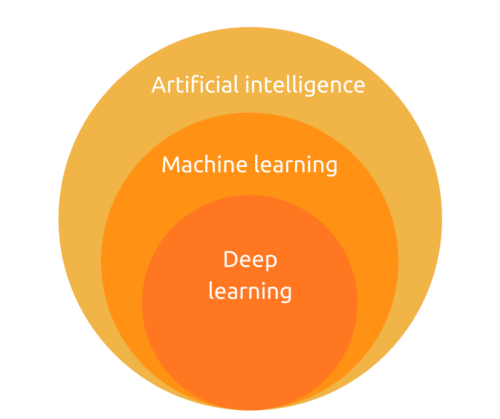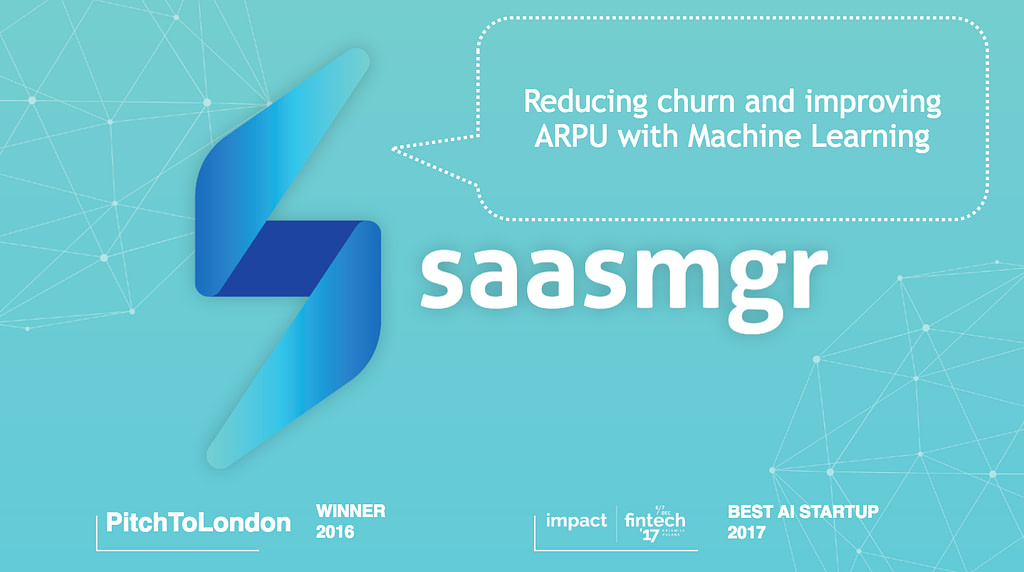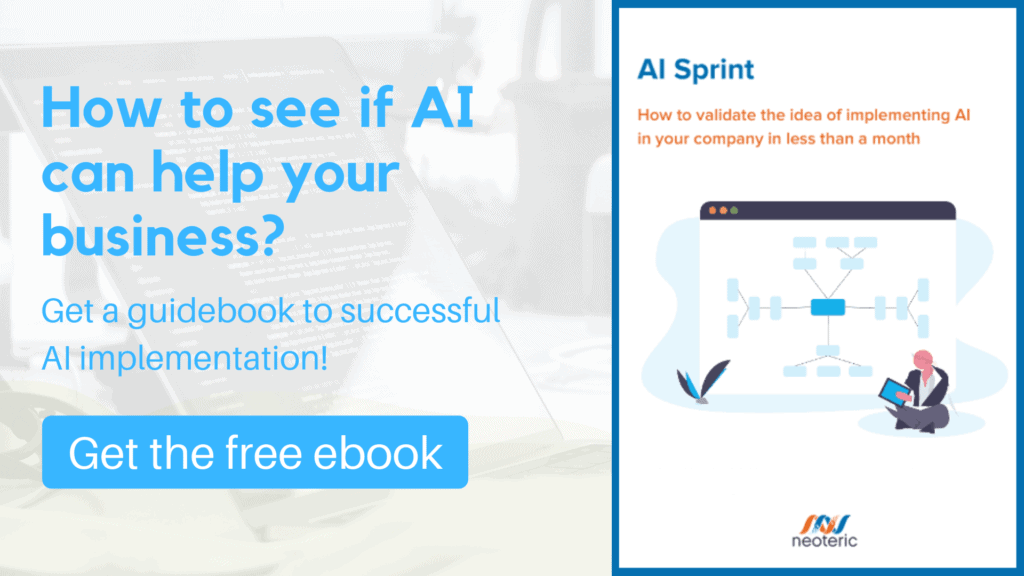Are computers smarter than us? Are we actually teaching machines to be masterminds? Will artificial intelligence put an end to humanity as we know it?
There’s so much drama in each of these questions, yet these are the topics that are widely talked about nowadays. Artificial intelligence and machine learning are so popular that they’ve become buzzwords, and it’s not limited to the tech industry. More and more articles, videos, and general conversations take on the topic of AI or ML. Despite the undeniable popularity, they are still not well-understood by the general public and, as terms, they’re often used interchangeably. More and more widely available apps claim to be AI-based, but there’s still not enough understanding of the value that AI may bring to both users and businesses. So is there a difference between artificial intelligence and machine learning? Are they something sophisticated and out of most businesses’ league?
Artificial Intelligence
When it comes to ML and AI, the latter is probably easier to grasp for people. Have you seen The Terminator, Matrix, Transcendence or Ex Machina? All of them focus on artificial intelligence and we’re used to this representation of what AI is: a human-like machine that is able to think for itself. That’s not the case, really, as artificial intelligence is a much wider concept. Artificial intelligence is any code or algorithm that enables machines to mimic, develop, and demonstrate human behavior. We are now in the era of ‘’weak AI’’ – meaning that the existing technology is still in its infancy, while it is expected that in the future machines will be capable of everything humans can do. Even more simply: AI is a concept of machines being able to perform tasks typical of human intelligence, including recognizing objects and sounds, understanding language, planning, and problem-solving.
AI is an exciting topic because it gives us space to daydream about where humanity can go. Humans, as a species, have always expressed the will to develop and get further, and since we want technology to assist us in doing so, it’s only natural that we use ourselves as a blueprint. That’s probably why AI is often associated with the physical form of a robot when in reality it does not have to look like one. When we want to understand where AI is going, we first need to understand AI as it is now. There are two fundamental groups within this field of study: applied AI and generalized AI. Applied AI uses human-like patterns to perform one specific task. That’s the area which is already providing breakthroughs, as we’re seeing more and more advanced technology which can be used e.g. in medicine to diagnose patients, and with high accuracy! Generalized AI, on the other hand, is all about developing intelligent systems that can easily perform any task, much like a real person. This area may be the most intriguing for people, but it’s still in the future, though probably not very distant as researchers are constantly developing this concept.
Machine learning
Machine learning is a way of achieving AI: all the techniques and processes that bring machines closer to ‘understanding’ human cognition and behavior are broadly categorized under this name. ML is based on the idea that we should provide machines with access to data that they can analyze in order to learn. Bernard Marr, an expert in the fields of digital transformation and intelligent use of data in business, writes: The field of research which has been most fruitful in recent years is what has become known as “machine learning”. In fact, it’s become so integral to contemporary AI that the terms “artificial intelligence” and “machine learning” are sometimes used interchangeably.
However, this is an imprecise use of language, and the best way to think of it is that machine learning represents the current state-of-the-art in the wider field of AI. The foundation of machine learning is that rather than have to be taught to do everything step by step, machines, if they can be programmed to think like us, can learn to work by observing, classifying and learning from its mistakes, just like we do. It is possible to achieve AI without machine learning but that would require millions of lines of code. That’s a very complex process. Without machine learning, artificial intelligence would have to be written from A to Z. That’s like actually sitting down and teaching AI everything piece by piece, while ML is more like providing it with information and tips and letting it learn on its own.
Read also: 6 ways to use artificial intelligence in e-commerce
Deep learning
When talking about machine learning, one cannot avoid the topic of ‘’deep learning’’. Just like ML is a part of AI, deep learning is a subcategory of machine learning. Deep learning was inspired by the structure and functioning of a human brain and requires artificial neural networks (ANN). Such a network contains nodes in different layers and allows communication between the layers. Deep learning is supposed to make sense of voluminous sets of data, but it ‘’learns’’ in a different way. In ML, the machine learns from data provided to it. If we want AI to be able to distinguish a cat from a dog, we will give it hundreds of pictures.
Peter Jeffcock from Oracle writes: If I give you images of horses, you recognize them as horses, even if you’ve never seen that image before. And it doesn’t matter if the horse is lying on a sofa, or dressed up for Halloween as a hippo. You can recognize a horse because you know about the various elements that define a horse: shape of its muzzle, number and placement of legs, and so on.
Deep learning can do this. And it’s important for many things including autonomous vehicles. Before a car can determine its next action, it needs to know what’s around it. It must be able to recognize people, bikes, other vehicles, road signs, and more. And do so in challenging visual circumstances. Standard machine learning techniques can’t do that.

Why are AI and ML so popular now?
Even though these topics have been around for decades (the term ‘’artificial intelligence’’ was coined in 1956), up until now they were not ‘’mainstream’’ interest subjects. The rapid development of technology, along with all the entertainment creations it has inspired, brought AI to the attention of a wider audience, and now big data mixes things up.
In case you need big data explained: it refers to extremely big data sets that can be computationally analyzed to identify patterns and trends regarding human behaviors and interactions. Nowadays, we keep a lot of things (if not everything) online and the data on what we do is collected and analyzed. And that’s a huge opportunity for businesses as they can get insights into the lives of their customers. But analyzing huge data sets is impossible for a person. With an infinite number of data points and constant generation of new information, it is just impossible for a human to sort and assess all the data. And we really do produce a lot of data. According to the 2014 EMC Digital Universe study, the volume of data in 2013 was 4.4 ZB and is expected to grow to 44 ZB until 2020. So all of the tiresome, repetitive (but highly detailed) work related to handling all this data can be passed on to machines. The data processed by machines can then be used for the benefit of business: to target marketing, make recommendations or prepare personalized offers.
Is artificial intelligence just about data-handling?
No. Thanks to books and films we have all developed a fantasy of future in which the world is served, or sometimes even led, by robots. In the past, we used to think that the future would bring us flying cars and robot servants (remember The Jetsons?), then we started fantasizing about interacting with machines. We’re not surrounded by human-like robots but does that mean we don’t use artificial intelligence? In fact, we do, and we do it every day. There’s a whole variety of AI use that makes users’ everyday lives easier and, at the same time, provides companies with priceless insights into their customers’ preferences and behaviors. Artificial intelligence is not something that should intimidate business owners, it’s not an otherworldly technology anymore. Any business can use it and capitalize on the value brought by it. Let’s now look at some of the examples of how AI is used to benefit companies and their clients today.
Google’s predictions and commute tips
It’s now normal that Google maps show us alternative routes from place A to place B and measure how much time can be saved. We can also see where some roadworks are taking place or what the traffic is like right now. Google tells you how many minutes away you are from your destination. This doesn’t work like an old-fashioned bus timetable. Google gathers anonymized location data from smartphones and can analyze the speed of movement of traffic. As users can report roadworks or accidents, Google can also analyze this data in order to find the fastest route.
Ridesharing
When we think Uber, we think ridesharing. In reality, Uber is a huge tech company. They use machine learning to determine the price of your ride based on driver demand and supply and computing optimal pick-up locations.
Email: spam and categorization
Your inbox just does it. Spam filters are very effective. Simple rules such as ‘’filter out messages saying XYZ from unknown addresses’’ are not enough, so AI has a role to play even in a such a ‘’small’’ thing as spam email. The spam filters must constantly learn from the message data in order to filter out the unwanted messages. It is estimated that through the use of ML, Google successfully filters out 99.9% of spam email. A similar approach is used for categorizing emails into primary, social, and promotion inboxes. This, however, also requires some user intervention. Every time you mark an email, Gmail learns and uses new data to organize your inbox in a better way.
Credit decisions
If you ever applied for a loan or a credit card, you surely know that it doesn’t take days for the bank to process your application. Machine learning is used to develop the credit score and perform risk assessment. If the application is accepted, the user is then presented with a plan suited for their needs and possibilities. And all of that requires no human assistance.
Social networks
Facebook is the best example. Think about uploading a photo to Facebook: it automatically highlights people’s faces and suggests friends to tag – all thanks to face recognition, which is a field that Facebook heavily invests in. Facebook also uses AI to personalize users’ newsfeed and display targeted ads.
Virtual assistant
Siri, Alexa, Cortana, and Google Assistant. All of them are designed to perform tasks in response to voice commands or keystrokes. You can ask them questions or tell them to do things for you. Call mom. Set the timer for 10 minutes. Wake me up at 7 AM tomorrow. Play a relaxing song. A virtual personal assistant can find information, give directions, help to write messages, add events to calendar, and many more.
Recommendations
When you shop online, there is a list of products recommended for you. These are the ‘’Customers who bought this item also bought’’ lists. The recommendations are made up of the choices of customers who were interested in the products you are searching for, but also of your personal preferences. Amazon, for example, uses neural networks to generate personalized product recommendations for customers. But recommendations are not only for products you can order from an online retailer. Netflix provides highly predictive technology based on users’ reactions. It analyzes the choices and reactions of a user to generate a personalized list of recommendations.
Customer service
With access to a whole variety of services, clients are now more prone to changing service providers. Commodity businesses are struggling to retain customers, but in fact, they’re ill-equipped to do so. AI and ML enable companies to identify which client wants to leave, prepare a personalized offer (together with added services), and thus reduce churn. SaaS companies such as SaaS Manager use AI to help businesses provide high-quality customer service and build brand loyalty.

Where does all this data come from?
Big data has to come from somewhere. The data on our behavior comes from our online activities: what pages we browse, what we search for in Google, what we post on Facebook, what we buy online… Whatever you do on the internet leaves a trace that can be then analyzed. But there’s also the Internet of Things (IoT). IoT produces lots of data that can provide information about traffic, accidents, health, and many others. IoT can be a lot of different devices: from health monitors or fitness wearables to connected footballs, smart microwaves, and autonomous cars. Anything that connects to the internet and shares data is IoT. Given this variety, the amount of data produced by the IoT devices is huge. And that’s why IoT needs machine learning.
In a situation of informational overload, machine learning can analyze all the data and find the really meaningful conclusions. Imagine a situation in which healthcare adopts a similar approach to the one retail has now. A wearable device would track your health and provide real-time insight for the health service. As the device ‘’gets to know you’’, it would learn what is typical and what’s unusual for you as an individual. It would then react to any abnormalities. Is your heart rate at a level that’s unsafe? In such a situation, the doctor receives a notification and can help you without any further delay.
This means that IoT and AI are intertwined. While AI is inspired by the human brain, IoT gathers information from sensors, which is much like the functioning of the human body. The information gathered by our eyes, ears or skin has to be processed to be made sense of. And that’s exactly how it works with artificial intelligence and drawing conclusions from large sets of raw data.
Human-like machines
Artificial intelligence, machine learning, deep learning (and whatever comes next) will probably gain on popularity in the upcoming years thanks to the advancements that are being made. The way businesses make use of AI now is already impressive, and with the developments the future brings, the way companies interact with clients may get to a whole new level. Is it a risk to jump into AI-based products for your business now? Not really. It doesn’t require a company to have an in-house team of engineers maintaining the AI, it’s a service. Though the use of artificial intelligence may be a little pricey, the advantages that come with it are undeniable.
AI is all around us and that’s something that won’t change but we really can’t answer the question where technology is going. We may try to predict what AI will be like in 5 years time, but in reality, the future is a mystery. And that’s probably a factor contributing to the fame of AI: when we don’t know what the future will bring us, we can imagine whatever we want. We may have only autonomous cars. We may have all self-doing home appliances. We may be connected to a variety of IoT devices that will track everything about our lives. We may develop an intelligence smart enough to lie to us. And we may want to interact with machines much like we now do with other people. But nothing’s a hundred percent certain. A part of its beauty is in the unknown.

